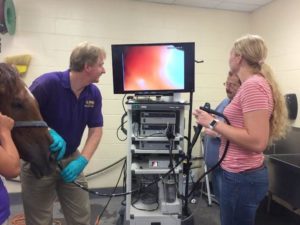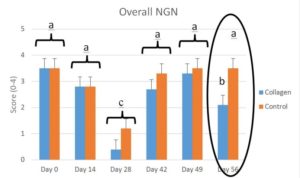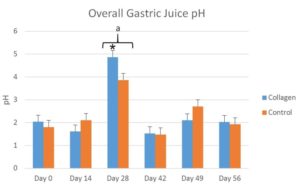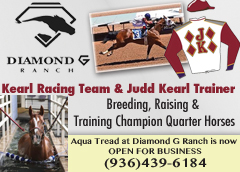The Equine Report is pleased to share results of research conducted by the Equine Health Studies Program of the School of Veterinary Medicine of Louisiana State University.
Authors: Frank M. Andrews1, Pilar Camacho-Luna1, Lisa Micheau2, Michael L. Keowen1, Frank Garza, Jr.1, Chin-Chi Liu1, Brian Lamp3, Jos Olijve4
1 Equine Health Studies Program, Department of Veterinary Clinical Sciences, School of Veterinary Medicine, Louisiana State University, Baton Rouge, LA, USA
2 Ecole Nationale Veterinaire De Toulouse, Toulouse, France
3 Sonac – Darling Ingredients, Mukwonago, Wisconsin ,USA
4 Sonac – Darling Ingredients, Son, The Netherlands
Louisiana State University’s Equine Health Studies Program, under the direction of Dr. Frank Andrews, conducted a study evaluating the effects of porcine collagen (connective tissue) product on maintaining stomach health in horses that are prone to stomach ulcers. Horses have a compound stomach (Fig 1), and up to 90% of performance horses suffer from gastric ulcers.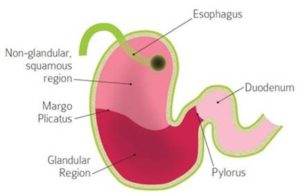
Fig 1. The horse stomach. Referred to as a compound stomach with both nonglandular squamous and glandular regions. The nonglandular squamous region is most prone to ulcers in performance horses.
Omeprazole (Gastrogard®, Merial LTD, Duluth, GA) is FDA-approved in the US for treating stomach ulcers. However, it is expensive and must be given daily during training and racing, which most performance venues do not allow. In addition, ulcer recurrence is common after discontinuing treatment. Thus, the development of effective management strategies and natural feed supplements, like hydrolyzed collagen, to prevent ulcer recurrence and promote stomach health is needed. Hydrolyzed collagen (HC) (Darling Ingredients, Irving, TX, USA) is a supplement containing bioactive peptides (proteins) and Type 1 Collagen, which promotes stomach health in other animals.
The purpose of this study was to evaluate the effect of supplement containing porcine hydrolyzed collagen (HC) on stomach ulcer scores and gastric juice pH in stalled horses fed a typical performance hay and grain diet.
We believed that hydrolyzed collagen would prevent the worsening of stomach ulcers in stall-confined horses after omeprazole treatment in stall confined horses without altering the normal acidity of the stomach.
We evaluated 10 Thoroughbreds that were a part of our resident herd. The horses were housed in stalls and fed hay and either hydrolyzed collagen mixed in grain or grain alone for 56 days. One group received 45g HC (Mw 2.5kDa from porcine bone, Sonac) mixed with 2.2 lbs sweet feed (Omelene 100, Purina Animal Nutrition). The control group (C) received 2.2 lbs sweet feed only. The sweet feed and mixed grass hay (1.5% body weight) was given twice daily for two 56 days periods. From day 14-28, both groups received omeprazole (4.0mg/kg, orally, once daily). The stomachs of the horses were scoped (Fig 2) during the study to determine if ulcers were present.
Fig 2. Horses were scoped during the study using a 3 m endoscope (Karl Storz, El Segundo, CA). Scoping is the only procedure to tell whether horses have stomach ulcers.
The stomach liquid (gastric juice) was aspirated and pH was measured at each scoping. Nonglandular gastric ulcer number (NGN) and severity (NGS) scores, 0 (no) to 5 (severe) were assigned by Dr. Andrews. Statistical analysis was done on the ulcer scores and pH measurements to determine differences.
Results
- Hydrolyzed collagen, mixed with grain, was safe and readily eaten by all horses, and did not result in any adverse effects.
- Mean gastric ulcer scores were lower at each scoping examination and a significant treatment effect was seen in the nonglandular region on day 56 of the study (Fig 3).
Fig 3. Mean endoscopic nonglandular number score (NGN 0-4) in horses on Day 0 (before) and Days 14, 28, 42, 49 and 56 after feeding HC (45 g, mixed in grain twice daily). Horses were given omeprazole paste (4.0 mg/kg, orally, once daily) from Day 14 to 28 and horses were exposed to an alternating feed deprivation model from Days 42 to 49. Different lower case letters denote significant (P<0.05) day and treatment*day differences.
- Stomach pH (acidity) values were low and variable throughout the trial, except on day 28 when pH was significantly higher in HC supplement-treated group compared to control group while on omeprazole treatment (Fig 4).
Fig 4. Mean gastric juice pH in horses on Day 0 (before) and Days 14, 28, 42, 49 and 56 after feeding HC (45 g, mixed in grain twice daily). Horses were given omeprazole paste (4.0 mg/kg, orally, once daily) from Days 14 to 28 and horses were exposed to an alternating feed deprivation model from Days 42 to 49. *denotes a significant treatment by day effect and a denotes a significant day effect.
Discussion and Conclusions
- Hydrolyzed Collagen-fed horses had fewer and less severe ulcers throughout the trial and significantly fewer ulcers were seen after 56 days of feeding (Fig 5).
- Hydrolyzed Collagen ameliorated the severity of gastric ulcers in stall-confined horses undergoing stall confinement and feed stress.
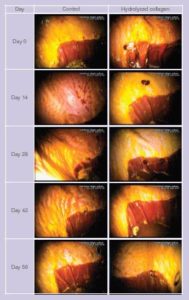
Fig. 5. Stomach ulcers in a horse before feeding hydrolyzed collagen and after 56 days of feeding hydrolyzed collagen. Note improvement in ulcers in the horse fed hydrolyzed collagen.
- Hydrolyzed collagen is found in several supplements on the market including pure Hydrolyzed Collagen (Sonac, Irving, TX) and also contained in SmartGut® Ultra pellets (SmartPak™ Equine, Plymouth, MA).
Acknowledgments
The authors thank the technicians, lab assistants, and student workers who supported this study. Funding for this study was provided by Darling Ingredients, the Equine Health Studies Program (EHSP), Louisiana State University School of Veterinary Medicine. All housing and scoping procedures were approved by the Institutional Animal Care and Use Committee (IACUC).

